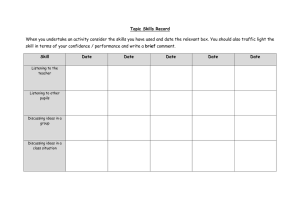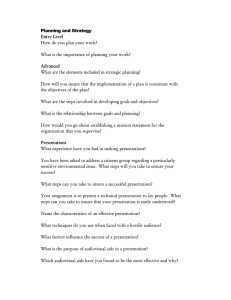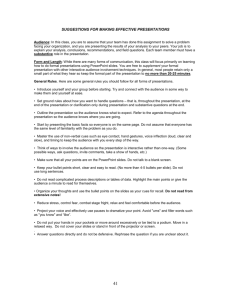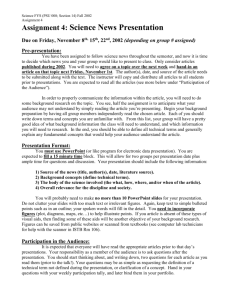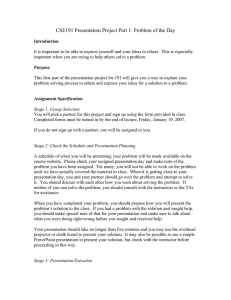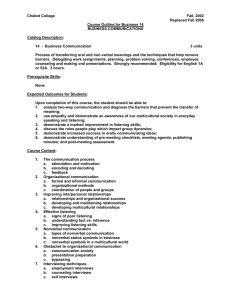Oral Presentation Guide: Planning & Delivery Tips
advertisement
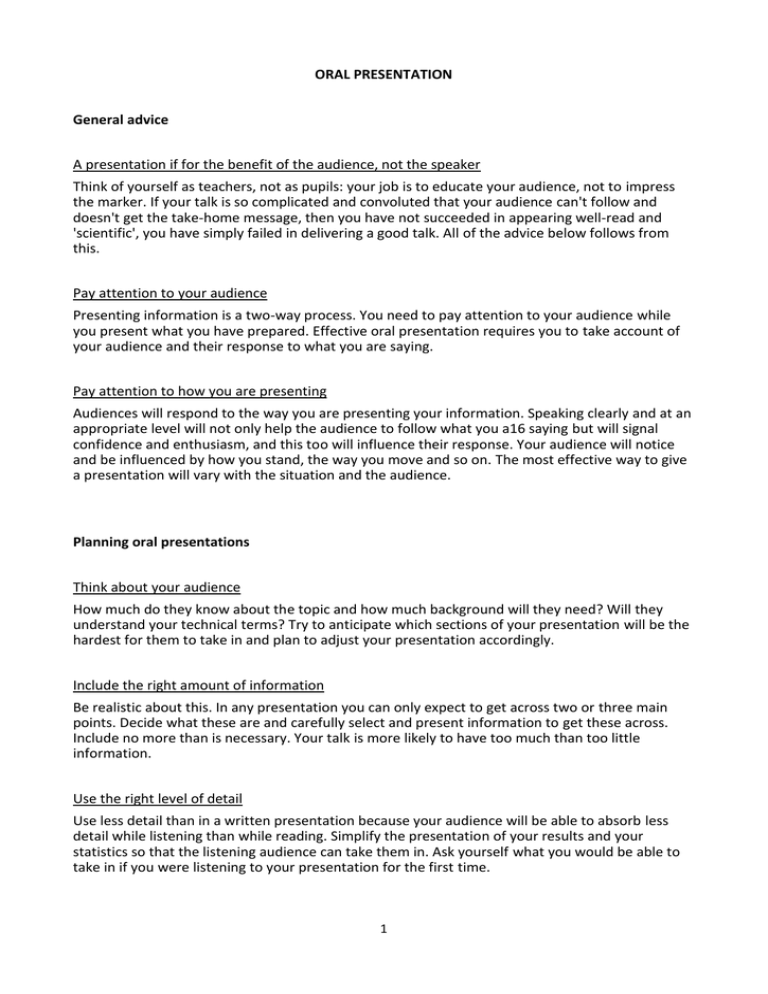
ORAL PRESENTATION General advice A presentation if for the benefit of the audience, not the speaker Think of yourself as teachers, not as pupils: your job is to educate your audience, not to impress the marker. If your talk is so complicated and convoluted that your audience can't follow and doesn't get the take-home message, then you have not succeeded in appearing well-read and 'scientific', you have simply failed in delivering a good talk. All of the advice below follows from this. Pay attention to your audience Presenting information is a two-way process. You need to pay attention to your audience while you present what you have prepared. Effective oral presentation requires you to take account of your audience and their response to what you are saying. Pay attention to how you are presenting Audiences will respond to the way you are presenting your information. Speaking clearly and at an appropriate level will not only help the audience to follow what you a16 saying but will signal confidence and enthusiasm, and this too will influence their response. Your audience will notice and be influenced by how you stand, the way you move and so on. The most effective way to give a presentation will vary with the situation and the audience. Planning oral presentations Think about your audience How much do they know about the topic and how much background will they need? Will they understand your technical terms? Try to anticipate which sections of your presentation will be the hardest for them to take in and plan to adjust your presentation accordingly. Include the right amount of information Be realistic about this. In any presentation you can only expect to get across two or three main points. Decide what these are and carefully select and present information to get these across. Include no more than is necessary. Your talk is more likely to have too much than too little information. Use the right level of detail Use less detail than in a written presentation because your audience will be able to absorb less detail while listening than while reading. Simplify the presentation of your results and your statistics so that the listening audience can take them in. Ask yourself what you would be able to take in if you were listening to your presentation for the first time. 1 Get the length and timing right You will always be told how much time is allocated for your presentation. Rehearse your finished presentation to get the timing right. Be aware that you may find the actual presentation takes longer when you are referring to diagrams and figures. The time allocated to you will usually include time for questions so leave plenty of time for this. If you finish in good time for questions and there are none, no-one will mind, in fact it may help the organiser to catch up on the schedule. It is bad manners to over-run your time and take time away from the next presenter. Organise your material If you do this well you will make it easier for your audience to understand you. Try a three-part organisation where you say what you are going to say, then say it, and then say what you have said. If you do this your audience will be clear throughout the presentation where you are going and how the current topic fits into the overall scheme. You may notice how similar some of these aspects of planning a presentation are to planning an essay or an examination answer. Good oral presentation involves planning, presenting appropriately to the situation and audience, and listening and looking as well as talking. Specific advice on short research presentations Engage the audience 1. Be confident and enthusiastic. You know more about your project than anyone else. You don't need to do too much, just use your posture and gestures to convey your authority and enthusiasm for the work you are reporting. 2. Engage your audience from the start. Begin with a rhetorical question or a brief anecdote to introduce the topic you have investigated, e.g. "Have you ever wondered why you can concentrate better in the morning, while others do better late at night? 3. Make eye contact with individuals in the audience, and with as many as possible in all parts of the room, Give them all a sense that you are communicating with them. 4. As well as starting well, finish well. Signal the end, and finish your presentation with an obviously concluding sentence. 5. Listen carefully to the questions the audience ask. If you don't understand a question, ask for clarification. Reply in a simple direct way. If someone asks a question to which you don't have the answer, don't be afraid to say so. If someone makes a critical point, take it as a helpful comment. You may be able to use it to improve your write-up. 6. Involve the whole audience when responding to questions. Communicate clearly and use visual aids 7. Speak clearly and at a sufficient volume, facing the audience as much as possible. Don't talk to the projector screen. 8. Do not read from your notes. Speak freely and spontaneously. The fewer the notes you have the better. 2 9. Make use of visual aids to explain models or outline arguments. A diagram of an experimental set-up can be more effective than several minutes of explanation. 10. Don't put too much information onto visual aids: set a maximum of five short points on each. One slide per minute is probably more than most people can keep up with. 11. Don't use too many slides. Don't be afraid to turn off the projector and walk away from it for a minute or two if you do not need it, 12. Make the text big enough. For an audience seated 20 feet away characters need to projected at least 2". Use at least 24pt lettering on an 44 sized page. If possible, find out the size of the projection surface in advance and work out how big you need to make your lettering. Encourage questions! 13. The only benefit the speaker can get from a talk is the input from the audience: Interesting and insightful questions - show that you have given an interesting and insightful talk (if nobody asks any questions, it probably means you have put them all in a coma); - show that you have given an engaging talk (people feel that you have spoken to them, rather than above their heads, and are now willing to return the favour); - will help you to get things clear in your mind you were uncertain about (if somebody points out a flaw in your argument: thank them - they are being helpful!); 14. Question time is a chance for you to talk about information that was too detailed to fit into the talk. Make sure that all members of the group participate equally in the presentation. Plan how the roles can be allocated and enacted to provide a coherent and fluent presentation. In group presentations, act as a group 15. Make sure that all members of the group participate equally in the presentation. Plan how the roles can be allocated and enacted to provide a coherent and fluent presentation. 16. When another member of your group is doing his or her bit, look at them and pay attention. It is distracting for the audience if you appear distracted and uninterested. 17. When it is your turn, be a good audience. As well as making your presentation, you are expected to listen to the presentations of other groups in your session. Stay to the end and make an active, visibly attentive and helpful contribution. Ask questions: this can be helpful both to the group making the presentation and to the rest of the audience. 3
